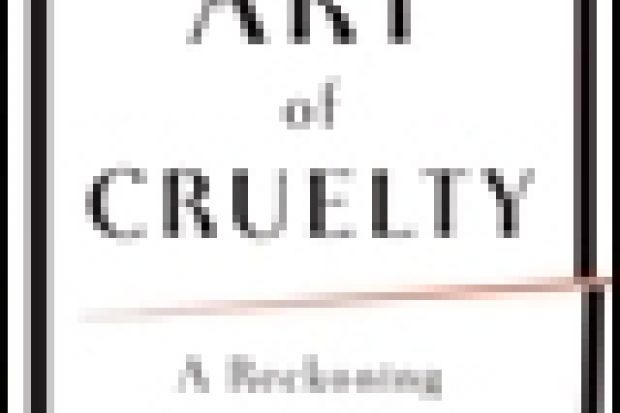Pay attention to the subtitle: A Reckoning. This is an account of the art of cruelty, but if you are expecting a genre guide, prepare to be disappointed. Rather, it is a settlement of scores, driven by a wish for resolution to the issues encountered by all of us in the face of images of violence. The majority of the works examined here are not the banal images of violence that we encounter every day. Rather, they are images that we wish we wanted to avoid but cannot help wanting to watch. What makes this book engaging is Maggie Nelson's frank admission of fascination for the cruel, despite ethical considerations and feelings of revulsion.
It begins with so much philosophical consideration that one wonders where the art itself has gone. Sade, Brecht, the Surrealists and Futurists all appear, but as theorists, jostling with Aristotle, Nietzsche, de Beauvoir, Baudrillard and Sontag. Nelson not only asks what cruelty is but what art itself is. A few works of art are mentioned, but more as way-markers on a tour through theory than as objects of investigation, with Nelson assuming that the reader is familiar with a vast range of artistic production. Some artists will indeed be known to most: Antonin Artaud frames Nelson's narrative and Francis Bacon and Sylvia Plath are her constant companions, sometimes almost to the detriment of others, but in retrospect these well-known characters of cruel art provide a backbone to an exploration that sometimes threatens to lose focus.
When Nelson does eventually provide examples from literature, film and art, the sheer number, and the pace at which she enumerates them, is vertiginous. Many instances of cruelty and its representation flicker past, from the Abu Ghraib photos to Hollywood horror; from Yoko Ono to Franz Kafka. But some pieces she mentions really stay with you. Nelson's book will make you go and find these works - and leave a disturbing history of Google searches on your laptop.
In Rhythm 0, artist Marina Abramovic stands motionless for six hours, allowing audience members to interact with her by using any of 72 objects, ranging from the innocuous (feather, rose, olive oil) to the deadly (knife, bullet, gun). The performance starts innocently but ends with Abramovic's clothes ripped, her skin cut and a gun pointed at her head. The disturbing video Family Tyranny, by artist Paul McCarthy, conspicuously does not re-enact child molestation using a plastic tube, mayonnaise, a styrofoam ball and a baseball bat. And who can forget or ignore the artistic happenings of the Viennese Actionists, which included public copulation, defecation and the slaughtering of animals - often simultaneously. These are the images of violence and cruelty you wish you could ignore, but in spite of yourself, must find and see.
Nelson thus takes us along on her journey of exploration and reckoning, not so much demonstrating and explaining but making us experience and think about the art of cruelty with her. The book's strength lies in her frank, disarming and absolutely personal way of doing theory. Not only does this inevitably draw the reader in but it makes for a good read. She performs the feat of writing a very discursive text, meandering around its subject in wide loops and turns, and at the same time producing an incisive and astute consideration, not only of the art of cruelty but of art itself, and our relationship to it as spectators, participants and humans.
The Art of Cruelty: A Reckoning
By Maggie Nelson
W. W. Norton & Company 288pp, £17.99
ISBN 9780393072150
Published 13 January 2012
